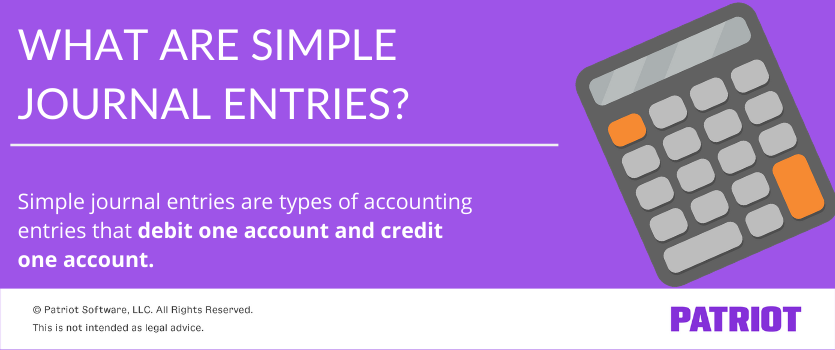Let’s face it: accounting is confusing. There are so many rules to follow and calculations to do. But, it’s one of those things you have to do for the sake of your business. So instead of diving straight into the complicated stuff, start slowly with simple journal entries.
Simple accounting journal entries are relatively easy to create because they only involve two accounts. Ready to get started?
What are simple journal entries?
In double-entry bookkeeping, simple journal entries are types of accounting entries that debit one account and credit the corresponding account. A simple entry does not deal with more than two accounts. Instead, it simply increases one account and decreases the matching account.

A simple journal entry typically includes the following information:
- 2 accounts
- 1 debit
- 1 credit
- Date
- Notes
Take a look at how a simple journal entry might look in your books:
| Date | Account | Notes | Debit | Credit |
| X/XX/XXXX | Account 1 | X | ||
| Account 2 | X |
If you’re wondering what in the world a debit and credit is, let’s take a second to recap these accounting cores.
Debits and credits are opposite entries that must equal one another. Your debit column total must be the same as your credit column total.
When you debit an account, you need to credit another account (and vice versa). Because of this, debits and credits oppositely affect the different types of accounts in accounting.
Debits increase asset and expense accounts. They decrease liability, equity, and revenue accounts.
Credits work oppositely. A credit increases liability, equity, and revenue accounts. Credits decrease asset and expense accounts.
Simple and compound entry in accounting
Not all journal entries are as easy as simple accounting entries. There are also compound journal entries.
You’ll likely need to make both simple and compound entries when you manage your business’s books.
Compound journal entries involve more than two accounts. A compound journal entry could have as little as three accounts, or it could reach double digits (e.g., payroll accounting entries).
Unlike simple journal entries, which only deal with one debit and one credit, compound entries have two or more debits, credits, or both. Although you’re dealing with multiple debits and credits in a compound journal entry, they still need to equal one another.
Take a look at a compound journal entry example:
| Date | Account | Notes | Debit | Credit |
| X/XX/XXXX | Account 1 | X | ||
| Account 2 | X | |||
| Account 3 | X | |||
| Account 4 | X |
When do you need to use simple accounting entries?
You can use a simple journal entry to record a transaction that only affects two accounts.
If a transaction affects more than two accounts, you can create multiple simple journal entries instead of a compound entry.
Again, use simple double-entry bookkeeping whenever a transaction involves only two accounts. Here are a few examples:
- Making a sale on credit—services
- Transferring money between accounts (e.g., checking to savings)
- Making a purchase
- Refunding customers
Simple journal entry examples
Here are a few instances when you may need to create simple journal entries.
Making a sale on credit—services
When a customer purchases a service on credit, you must use the Accounts Receivable (AR) account to record the transaction. Debit your AR account to reflect the increase in money you will have. And, credit your Sales account.
Let’s say you mow a customer’s lawn for $100. You extend credit to the customer, so they don’t pay you right away. Your simple journal entry would look like this:
| Date | Account | Notes | Debit | Credit |
| X/XX/XXXX | Accounts Receivable | Lawn mowing service | 100 | |
| Sales | 100 |
Keep in mind that creating a sales journal entry for goods may involve a number of other accounts, such as Sales Tax and COGS Expense accounts.
Transferring money between accounts
Depending on the situation, transferring money between accounts may call for a simple journal entry.
Let’s say you want to withdraw $5,000 from your Checking account and deposit it into your Savings account. To do this, debit your Savings account and credit your Checking account.
| Date | Account | Notes | Debit | Credit |
| X/XX/XXXX | Savings | 5,000 | ||
| Checking | 5,000 |
Making a purchase
In many cases, you can use simple journal entries to record purchases.
Say you want to buy $400 worth of new inventory from a vendor. You will use your Inventory account and a Cash or equivalent account. Debit the Inventory account and credit your Cash account.
| Date | Account | Notes | Debit | Credit |
| X/XX/XXXX | Inventory | 400 | ||
| Cash | 400 |
Refunding customers
When customers want a refund, you might give them cash or store credit.
Let’s say your customer wants to return a recent purchase for whatever reason. Their purchase was for $250, and they want a cash refund. Create a simple journal entry to refund your customer using your Sales Returns and Allowances and Cash accounts.
Debit your Sales Returns and Allowances account for $250. Credit your Cash account for the same amount.
Here’s how the journal entry should look:
| Date | Account | Notes | Debit | Credit |
| X/XX/XXXX | Sales Returns and Allowances | 250 | ||
| Cash | 250 |
Want an easier way to manage your business’s accounting books? Use Patriot’s online accounting software to streamline your recordkeeping. Record incoming and outgoing money without the hassle of using spreadsheets. Start your free trial today!
This is not intended as legal advice; for more information, please click here.